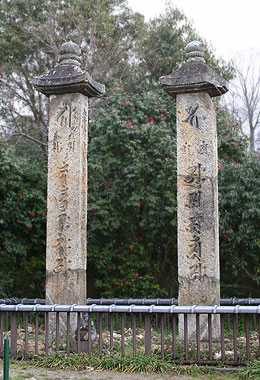|
||
 |
||

Hannyaji 般若寺 (Nara)
(C)2001 Japanese Architecture and Art Net Users System. No reproduction or republication without written permission.
掲載のテキスト・写真・イラストなど、全てのコンテンツの無断複製・転載を禁じます。
|
||||||
| kasatouba 笠塔婆 | ||||||
| KEY WORD : architecture / buildings & structures | ||||||
| Also called kasasotouba 笠卒都婆. A memorial
or grave stone. The most common has a square shaft *toushin
塔身, placed on a roughly hewed base stone. A pyramidal-like coping stone *kasa
笠, at the top suggests a roof. On top of the coping or between the coping and
top ornament is an onion shape *houju
宝珠, or bowl shape. Example: Ryuumonji 龍門寺 (1333) in Nara. Inscriptions in Sanskrit
letters may be carved into the shaft, or Buddhist deities may be rendered in low
relief on the upper part. The upper part is called butsugan kasatouba 仏龕笠塔婆
and may have solid stone wheels set vertically within the shaft so that the devout
can turn the stone while reciting invocatory prayers. An example of this type
is found at Akagi Jinja 赤城神社 (1490) in Gunma prefecture. It has Roku
Jizou 六地蔵 figures carved into it. |
||||||
 Hannyaji 般若寺 (Nara)
|
||||||
| REFERENCES: | ||||||
| EXTERNAL LINKS: | ||||||
| NOTES: | ||||||
(C)2001 Japanese Architecture and Art Net Users System. No reproduction or republication without written permission. 掲載のテキスト・写真・イラストなど、全てのコンテンツの無断複製・転載を禁じます。 |
||||||